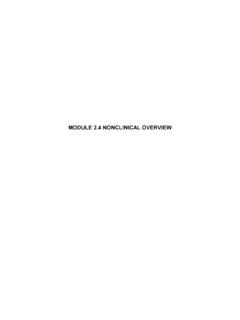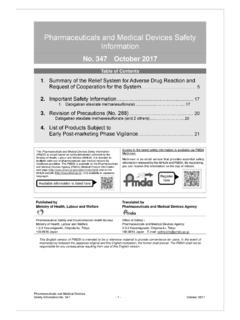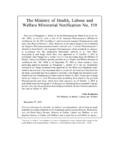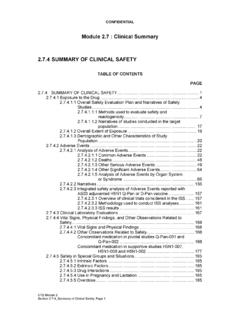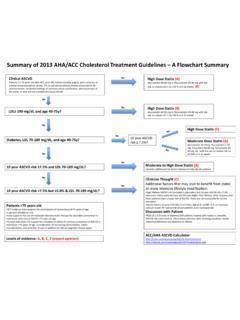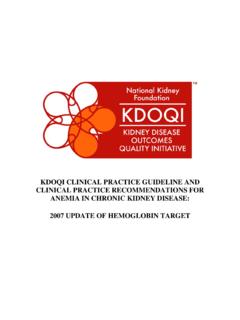Transcription of 2.7.2 summary of clinical pharmacology Studies
1 CONFIDENTIALRM2003/00379 summary of clinical Pharmacology2 Module of clinical PharmacologyCopyright 2003 the GlaxoSmithKline group of companies. All rights copying or use of this information is summary of clinical Pharmacology3 TABLE OF AND OVERVIEW OF clinical pharmacology .. of clinical pharmacology of Abacavir and .. for Once Daily Dosing for pharmacology Studies .. OF RESULTS OF INDIVIDUAL Studies .. CNA10905 .. Design and Data Analysis .. and Conclusions .. AND ANALYSES OF RESULTS ACROSS .. 1 summary of clinical Pharmacology4 ABBREVIATIONS3 TClamivudine (EPIVIR )ABCabacavir (ZIAGEN )AEAdverse EventAUC0-t,ssArea under the drug concentration-time curve from 0 to time t atsteady stateAUC Area under the plasma concentration versus time curve from time0 and extrapolated to infinityBIDT wice dailyCBV-TPCarbovir triphosphateCSFC erebrospinal FluidCIConfidence intervalCL/FApparent ClearanceCmaxMaximum drug concentrationCmax,ssMaximum drug concentration at steady stateCSFC erebrospinal FluidCt,ssConcentration at t hours post dose at steady stateddCZalcitabine (Hivid )DPDiphosphateEFVE favirenz (Sustiva )EUEuropean UnionFDCF ixed Dose CombinationGLPGood Laboratory PracticeGSKG laxoSmithKlinehHour(s)HIVH uman Immunodeficiency VirusHSRH ypersensitivity reactionkgKilogramLLiter zElimination rate constantmgMilligram(s)mLMilliliter(s)MPM onophosphate gMicrogram(s)
2 NRTIN ucleoside Reverse Transcriptase InhibitorPBLP eripheral Blood LymphocytePDPharmacodynamicsPKPharmacoki neticsRAccumulation ratiot Elimination half-lifeCONFIDENTIALRM2003/00379 summary of clinical Pharmacology5 ABBREVIATIONS CONTINUED tmaxTime to Maximum Concentrationtmax,ssTime to Maximum ConcentrationTPTriphosphateUSUnited StatesZDVZ idovudine (RETROVIR )CONFIDENTIALRM2003/00379 summary of clinical Pharmacology61. BACKGROUND AND OVERVIEW OF CLINICALPHARMACOLOGYThe clinical pharmacology of abacavir (ABC) and lamivudine (3TC) have beenextensively studied in both healthy volunteers and HIV-infected patients. This section ofthe submission presents an overview of the clinical pharmacology of ABC and 3TC(Section ) and the rationale for once-daily dosing of ABC (Section ). Lastly, summary results are presented from a recent clinical pharmacology study, CNA10905, tocharacterize plasma ABC and intracellular carbovir triphosphate (CBV-TP, the activemoiety of ABC) pharmacokinetics in support of once daily dosing of ABC as acomponent of the fixed dose combination (FDC) tablet of ABC/3TC (600mg/300mg) forthe treatment of HIV infection (Section 2).
3 Overview of clinical pharmacology of Abacavir AbacavirThe clinical pharmacology of abacavir (ABC) has been extensively characterized in thesubmissions for ZIAGEN and is briefly summarized in this section for is moderately lipophilic, has good water solubility, and shows rapid dissolution inneutral and acidic media. ABC has excellent absolute oral bioavailability (~83%). Theapparent volume of distribution after intravenous administration is L/kg, suggesting that ABC distributes into extravascular space. Whole bodyautoradiography Studies in mice have shown that after oral administration ABC-related14C-material is widely distributed throughout the body. Measurable concentrations ofABC were found in brain and/or cerebrospinal fluid (CSF) in mice, monkeys, andhumans. An in vitro study using primary bovine brain endothelial cells (an establishedblood-brain-barrier model) has shown that ABC permeates the brain endothelial cells bya passive diffusion mechanism and its permeability is greater than that of zidovudine(ZDV).
4 Binding to plasma proteins is moderate, approximately 50%. ABC isextensively metabolized by the liver, with less than 2% of the dose excreted asunchanged drug in the urine. It is primarily metabolized via two pathways, UDP-glucuronyl transferase and alcohol dehydrogenase, resulting in the inactive glucuronidemetabolite (361W94, ~ 36% of dose) and the inactive carboxylate metabolite (2269W93,~ 30% of dose). The remaining 15% of ABC equivalents found in the urine are minormetabolites, each less than 2% of the total amount recovered. The terminal eliminationhalf-life of ABC is approximately hours and is consistent over a dose range of 300 to1200mg single-dose administrations. Following multiple oral doses of abacavir 300mgtwice a day there is no significant accumulation of ABC. ZIAGEN is a Trade Mark of the GlaxoSmithKline group of in US Patent and Trademark summary of clinical Pharmacology7 Linear pharmacokinetics are observed for ABC from single doses of 600 to 1200mg andat steady-state following repeat doses of 300mg twice a day (600mg daily) up to 600mgthree times daily (1800mg daily).
5 After oral administration of a single 600mg dose ofABC in 20 patients, Cmax was g/mL (mean standard deviation [SD]) andAUC was g*h/mL. At 300mg twice daily, the steady-state peak plasmaconcentration (Cmax,ss) of ABC is approximately g/mL and overall exposure(AUC0-12,ss) is approximately g* extent of ABC absorption (AUC ) is not affected by food intake (standard high fatbreakfast: total calories 967 kcal, 24% carbohydrate, 14% protein and 62% fat).However, administration of ABC with a high-fat meal did reduce the rate of absorption,as evidenced by a decrease in Cmax of about 25-35% and delayed tmax of about hrs. The effect of food on ABC bioavailability is consistent with observations forother nucleoside analogs and is primarily due to a delay in gastric emptying after foodintake. The differences in tmax and Cmax are not considered clinically relevant since AUCof ABC has shown to be better correlated with its efficacy and no pharmacokineticparameter has shown significant correlation with toxicity [Weller, 2000].
6 ABC is not significantly metabolized by cytochrome P450 enzymes, nor is it involved inthe induction or inhibition of these enzymes. Therefore, it is unlikely that clinicallysignificant drug interactions will occur with drugs metabolized through these to different elimination pathways, no clinically significant drug interaction has beenobserved between ABC and 3TC. Although ABC and ZDV share a common metabolicglucuronidation pathway, no clinically relevant changes in the pharmacokinetics of eitherABC or ZDV have been observed with their concurrent of ethanol and ABC 600mg was studied in 24 HIV-infected males andresulted in an increase in mean ABC AUC by 41%; however, this change is notconsidered clinically relevant. ABC had no effect on the pharmacokinetic properties ofethanol. This interaction has not been studied in females. HIV-infected patientsreceiving methadone-maintenance therapy (40mg and 90mg daily) with 600mg ofZIAGEN twice daily (twice the recommended daily dose for ABC) may experienceincreased methadone clearance.
7 This alteration may require an increased methadone dosein a small number of of gender and ethnic origin were evaluated by a population pharmacokineticanalysis of ABC concentrations from four Phase II/III Studies and the results indicatedthat potential differences in ABC pharmacokinetics based on race or gender are due todifferences in lean body weight [GSK Document Number RM2000/00510/00]. However,the magnitude of this effect is insufficient to require any dosage adjustments based onbody size in related changes in ABC pharmacokinetics are observed in pediatric subjects,especially in children younger than 2 years old, resulting in lower exposures for a givenmg/kg dose compared to adults. Pediatric subjects require higher mg/kg doses thanadults, presumably due to increased metabolic rate. The current recommended oral doseof ZIAGEN for pediatric patients is 8 mg/kg twice daily (up to a maximum of 300mgtwice daily) in combination with other antiretroviral summary of clinical Pharmacology8 There are limited data for ABC in renal dysfunction.
8 ABC pharmacokinetics have beenstudied in six end stage renal disease HIV-infected patients and no changes wereobserved for ABC pharmacokinetics. ABC pharmacokinetics have been evaluated inpatients with mild hepatic impairment (Child-Pugh score of 5-6) and the data showedstatistically significant 89%, 26% and 58% increases, respectively, in ABC AUC , Cmaxand t after a single oral 600mg dose in these patients compared to patients with normalhepatic function. These changes suggested that ABC daily dose should be reduced inpatients with mild hepatic impairment due to altered ABC LamivudineThe clinical pharmacology of lamivudine (3TC) has been extensively characterized insubmissions for EPIVIR and is briefly summarized in this section for is a high solubility and high permeable drug with rapid dissolution. Consistent withthese properties, all formulations have shown rapid oral absorption with peakconcentrations generally achieved in to hours.
9 The bioavailability of oral 3TC inadults is typically between 80 and 85%. Autoradiography Studies in rat, and animal andhuman pharmacokinetic Studies have demonstrated that 3TC is widely distributedthroughout the body. The apparent volume of distribution after intravenousadministration is approximately L/kg. Binding of 3TC to human plasma proteins islow (<36% to serum albumin in vitro). The mean systemic clearance of 3TC isapproximately L/h/kg, with predominantly renal clearance (>70% of unchangeddrug) via glomerular filtration and active tubular secretion. Hepatic metabolism of 3 TCto the sulphoxide metabolite accounts for only 5-10% of an administered dose. Theobserved elimination half-life of 3TC is 5 to 7 linearity was demonstrated for both AUC and Cmax for doses ranging from to20mg/kg/day in adults after single- and multiple-dose oral administration. Values for z,t1/2 and CL/F were independent of dose over this dose range.
10 Mean (SD) steady-statepeak concentrations of approximately g/mL are obtained from 2mg/kg twicedaily dosing and occur at about 1 to hours after administration. After multiple-doseoral administration of 3TC 300mg once daily for 7 days to 60 healthy volunteers, steady-state Cmax was g/mL (mean SD) and the 24-hour AUC (AUC24,ss) ghr/mL. The average accumulation ratio (R) of is observed betweenfirst dose and steady-state. This is consistent and predictable from the terminal half-lifeobserved in single dose Studies (ranging 5-7 hours) and a 12-hour dosing has no known clinically relevant food interactions. 3TC administration is notrecommended for coadministration with zalcitabine (ddC, Hivid ) due to mutualinhibition of intracellular phosphorylation. 3TC elimination is inhibited by trimethoprim EPIVIR is a Trade Mark of the GlaxoSmithKline group of in US Patent and Trademark Office.
